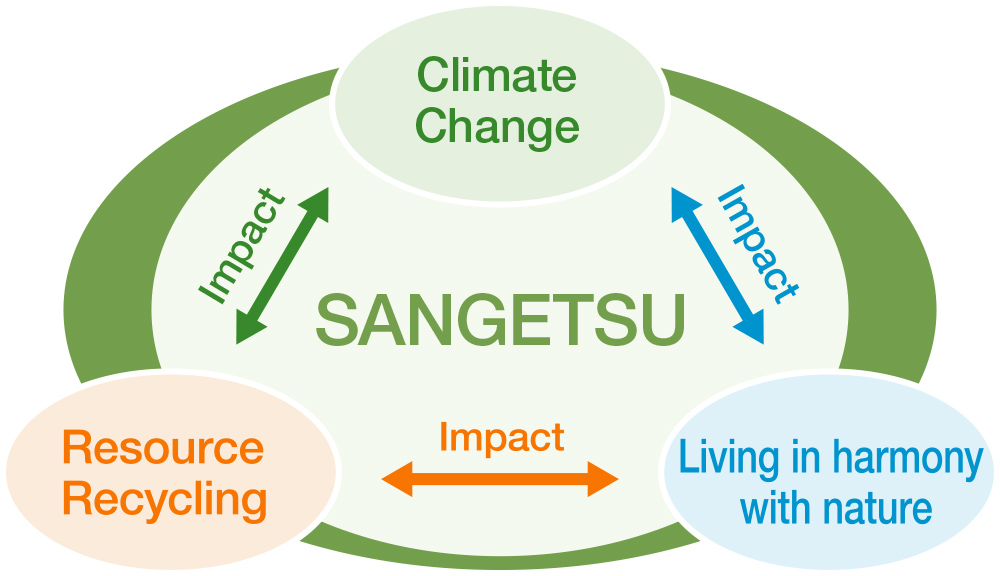
Environmental policy and promotion structure
Approach to Natural Capital

Our business activities are closely related to natural capital—the use of wood resources for our core wallcoverings and the use of fossil fuel energy for our manufacturing, delivering and construction processes—and we are aware that the conservation and restoration of natural capital is an extremely important issue. The construction industry that is closely related to our business has a growing need to select products that help reduce CO2 emissions and resource recycling for the selection of procurement items at the design stage, and we recognize that these issues need to be addressed for enhancing our corporate value over the long term. To address issues related to natural capital, we are implementing a variety of measures focusing on climate change, resource recycling and biodiversity. Given that all three of these affect one another, promoting them in an integrated manner is crucial for generating synergies while avoiding trade-offs between each initiative. An example that illustrates this is cutting down trees for installing solar power generation systems—this makes no sense as timber is an important natural capital for our company. Environmental issues are urgent challenges faced by society, and we will continue to work on resolving these issues from a range of perspectives related to our business activities, from product planning and development to manufacturing, procurement, proposals, deliveries, construction, and disposal.
Environmental Policy
Sangetsu has established its environmental philosophy and environmental policy premised on the notion that its initiatives involving environmental preservation entail duly assuming responsibility for providing better living spaces. As such, we will consistently promote environmental preservation activities in operating our environmental management system based on this policy.
* ISO 14001 certification acquired in June 2001
Basic Concept
Sangetsu has a role and responsibility to realize an affluent life by providing more comfortable living spaces. The business activities of Sangetsu are closely related to the environment. Thus, efforts to preserve the environment in the course of these activities are an obvious responsibility of the company. From this perspective, Sangetsu is striving to reduce the environmental load of its business operations, while giving greater consideration to preserving the global environment, in order to create a better living environment.
Our Approach
- Implement an environmental management system with appropriate environmental objectives and goals as well as continuous improvement to safeguard corporate operations and protect the global environment.
- Comply with legislation related to environmental preservation.
- Avoid the use of substances that adversely affect the environment; reduce waste, encourage recycling, and conserve energy and resources, in all stages of development, manufacturing, distribution, and use and disposal of products.
- Improve employee understanding and awareness of the company’s environmental policy and environmental management activities. Widely disseminate this environmental policy to relevant personnel and request their understanding and cooperation.
- Publically disclose this environmental policy
ESG and CSR Policies
Medium-term policy
- Monitor the environmental impact of the Sangetsu Group as a whole.
- Construct a system for preventing global warming and supporting the sustainable use of resources.
Implementation
(1) Reducing the environmental impact of business activities
- Reduction of greenhouse gas (GHG) emissions
- Reduction of energy consumption
- Reduction in volume of waste
- Rise in the recycling rate
(2) Understanding and reducing the environmental impact of the supply chain
- Understanding GHG basic unit for each supplier, and taking it into consideration during purchasing activities
- Understanding the Group’s environmental impact and drafting plan for reducing the environmental impact
(3) Developing and expanding eco-friendly products
- Developing the high durability product and expansion of the long-term continuation product
- Developing products that contribute to low carbon and resource recycling
(4) Building and expanding the sample book collection and recycling system
Related Links